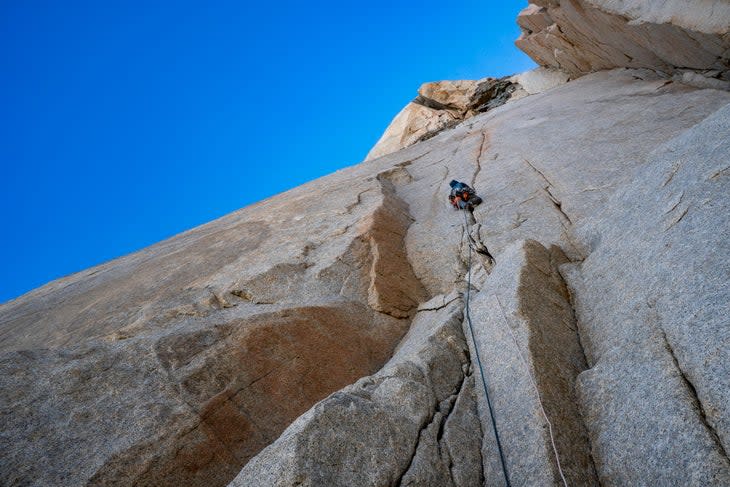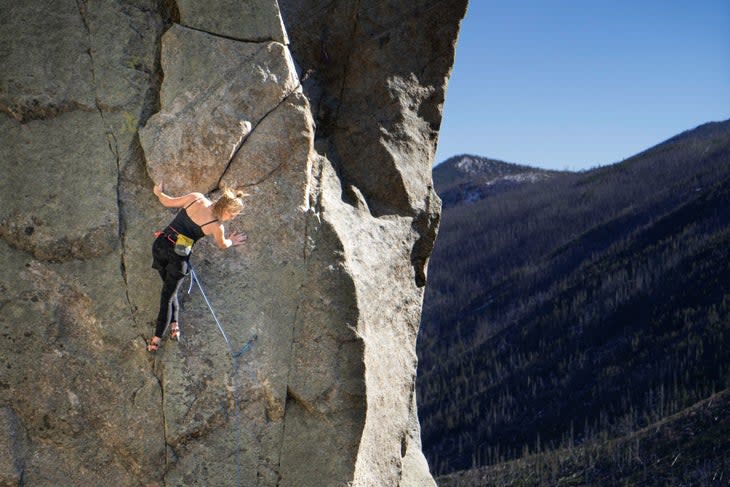How to Not Flip While Riding the Whip
This article originally appeared on Climbing
I have never (knock on wood) gotten my leg caught behind the rope while falling, but I've seen it happen in the Red River Gorge and in Rumney, and I've seen it happen during World Cups, and I've seen it happen at the gym, and I've seen it happen time and again while scouring the civil(ish) corners of the internet for schadenfreude(ish) distraction. So I know it happens. And I also know that these kinds of accidents--which generally involve flipping violently upside down and smashing your back and neck and head against the wall--can be very dangerous. Yet these upside-down whippers are almost always avoidable. As climbers and athletes, we generally know--or can know--where our leg is located in relation to our rope and last piece of protection. But it's up to us to codify that knowledge, to translate our arm-chair understanding into a practice so fundamental to the act of climbing that we are no longer likely to make these mistakes.

Part 1. Don't get tangled up in the first place.
Being aware is something you have to practice
One of the biggest reasons that people get their legs caught behind their rope is simple: They didn't know it was back there. This can be the result of ignorance (they didn't know better), complacency (they weren't paying attention), distraction (they were gripped as hell and forgot the fundamentals), or bad luck (which happens).
Given that the first three of these instances are in the climber's control, one of the best things you can do as a climber is to practice keeping your feet on the correct side of the rope--to think about it while you climb until, having thought about it enough, it becomes second nature. Watch Adam Ondra or Janja Garnbret or Sean Bailey or even that steady 5.12er at your local gym, and you'll notice that they're constantly dancing their feet around the rope as they climb--and that this movement is so baked into the way they see the wall and select their footholds that keeping their feet on the correct side of the rope takes almost no extra energy or thought. It does, however, take practice and good footwork to get to this point. So get out there and practice.
"Right" is not always right
One reason that beginners often make rope-management mistakes is that the correct position of your foot relative to the rope changes based upon the position of your body relative to your last piece of protection. If you're climbing up a straight line of bolts and holds in a gym, you generally want to straddle the rope: left foot on the left side, right on the right. But once your foot sequence starts traversing to either side of the bolt line, straddling the rope is no longer a good idea. Instead, you need to follow what Bennett Barthelemy describes (in a 2010 Climbing article) as the Rule of Opposites. "On wandering climbs, follow this simple rule: left is right, and right is left. That is, trail the rope off your left side when heading rightward, and vice versa when heading leftward."

The Rule of Opposites is obvious on true traverses (as demonstrated in the image above) but things get a bit trickier when you're just stepping to the side for a single move, or if you're angling your feet very subtly one direction or another, or if you're camming your feet into the same crack that your gear is in--but the same principle applies.
Don't be distracted
Mistakes in climbing tend to pile on top of each other. (Don't believe me? Check out my piece about how I rappelled off the end of my rope.) A disproportionate number of climbers get their legs caught behind their ropes when something else is going wrong. Paying attention to where you are relative to that last piece of pro can be tough when you're well above said pro and focusing all your gripped energy on making it to the next piece. Sometimes, in this distracted mindset, you might even be tempted not to bother adjusting your foot's position even if you know that it's in a bad place. BUT: Unless you're facing a lethal fall from your current position regardless of your vertical orientation (in which case, for God's sake, clip the heck in), you should bother to move your leg to the correct side of the rope, even if you're scared and tired and moving your foot also means increasing your risk of a fall. Big falls, though scary, are often quite safe, but big falls, when you're flipped upside down, are not safe at all.
Communication between belayer and climber
Since the biggest reasons that people get their legs caught behind their rope is that they didn't know it was back there, belayers--who are at least in theory paying attention to the climber, their rope, and the climber's body language--are a great resource. As a belayer, it should be easier for you to remain clear-headed when your climber cannot, which puts you in a good position to give advice. So when you're belaying, keep an eye out for your climber's leg and the direction of their foot--particularly if the climber seems unaware of where they are in relation to the rope or in a position where they're likely to fall.
As a climber, meanwhile, don't take your belayer's warnings as some sort of personal slight. It sounds ridiculous, but I've seen this happen and you probably have too. Time and again, climbers get pissed because they think a belayer's remark about their present-tense sketchiness somehow implies that they, the climber, are always sketchy, and that this is some sort of permanent slight against their character. Cut it out. Don't be so touchy. Not everything that's said about you extends to who-you-capital-A-are-as-a-person. Safety-specific communication between climber and belayer needs to be normalized and unladen with judgment. If you can't have that kind of dialogue with your partner, find someone else to climb with.
Part II. Things get complicated
Sometimes you've got to heelhook up by your hand but can't possibly get it underneath the rope. Sometimes the process of moving your foot changes the rope's angle and puts your other foot behind it. Sometimes you do everything right but then your foot slips and as you fall it skitters behind a loop of slack in the rope and etc.
Chaos and climbing are dear old friends. You cannot control for everything, especially when the climbing gets hard and weird. That's one reason why upside-downers are not uncommon even at the World Cup level, where the gymnastic, three-dimensional setting style often forces athletes into convoluted relationships with their ropes. (Thankfully, World Cup Lead routes tend to be very steep.)
If it's unavoidable--be aware of it.
On some climbs, keeping your leg on the correct side of the rope makes the climbing way harder. On Fat Camp, in Rifle, CO, my fellow digital editor Delaney Miller has found that there's one move--an across the body jump--that's just way harder to do if she takes the time to set up for the move with her foot on the correct side of the rope. So, after a few attempts, she decided to try something different: she'd jump with her foot on the wrong side of the rope but then kick it around the rope as part of that same motion. It worked--and that's become her beta, something she's practiced and thought about and drilled into her memory. Jump. Kick the foot. Grab the next hold. She's fallen there multiple times--and has never flipped over backward. The extent to which this beta is reasonable, however, is contingent on another factor: the consequences of flipping over are relatively minor on Fat Camp, since the route, located in Rifle's Wicked Cave, is quite steep. Miller might get some rope burn on the back of her leg, but she'd be unlikely to bash her skull.
This was not the case for Steve McClure on Rhapsody, an Ell 7a (5.14 R) at Dumbarton Rock, in Scotland. In the following video, you can watch McClure as he climbs high through the route's notorious runout and decides not to make the sequence harder by worrying about extracting his leg from behind the rope. Instead, he takes note of where his foot is and, when he does fall, quickly kicks his foot back around the rope before it goes taught. Recommended beta? Not at all. But it's nonetheless impressive and a good demonstration of your options: If you are in a position where you are likely to fall with your ankle behind the rope, you can try to disentangle it as you fall... good luck.
Part III. Making the falls as safe as you can
Wear a helmet
Before I get all preachy, I should admit that I have only rarely worn a helmet since I started climbing in 2004--almost never while sport climbing, only occasionally when trad climbing. This is largely because, as a born wimp, I grew up specializing in steep routes, where there is far less of a chance that you'll strike the wall when you fall. Indeed, I didn't even own a helmet until sometime around 2015. But after a year of watching nearly constant whipper footage and reading accident reports, I've got a new appreciation for (a) how easy it is for even highly experienced climbers to occasionally get their leg caught behind the rope, and (b) how gnarly those upside-down falls can actually get. Even when the climber doesn't hit the rock (and they generally do), they almost always seem to suffer some degree of whiplash. So (do as I say, not as I do) I wholeheartedly recommend wearing a helmet--particularly on any route that's less than 15 or 20 degrees overhanging, navigates ledges or other obstacles, is multiple pitches long, or is not bolt protected.
Make sure you (and your belayer) know how to give a soft catch
I'd also advise you to work closely with your belayer to make sure you know how to catch a dynamic fall. If your leg is behind the rope, a soft catch will decrease the likelihood and severity of rope burn; it also might even mean that you've got more time to extract their leg from behind the rope entirely. But more importantly the difference between hitting the wall softly and hitting the wall hard can, when you're falling upside-down, be the difference between minor injury or serious injury, life or death.
Steven Potter is a digital editor at Climbing. He's been flailing on rocks since 2004, has successfully injured (and unsuccessfully rehabbed) nearly every one of his fingers, and holds an MFA in creative writing from New York University.
For exclusive access to all of our fitness, gear, adventure, and travel stories, plus discounts on trips, events, and gear, sign up for Outside+ today.

